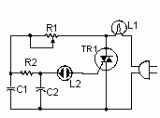15 seconds delayed switch-off
A good idea for bedroom lamps
Parts:
R1 470R 1/2W Resistor
R2 100K 1/4W Resistor
R3 1M5 1/4W Resistor
R4 1K 1/4W Resistor
C1 330nF 400V Polyester Capacitor
C2 100µF 25V Electrolytic Capacitor
C3,C5 10nF 63V Polyester or Ceramic Capacitors
C4 10µF 25V Electrolytic Capacitor
D1,D2 1N4007 1000V 1A Diodes
D3 BZX79C10 10V 500mW Zener Diode
D4 TIC206M 600V 4A TRIAC
Q1 BC557 45V 100mA PNP Transistor
IC1 7555 or TS555CN CMos Timer IC
SW1 SPST Mains suited Switch
Device purpose:
This circuit is intended to let the user turn off a lamp by means of a switch placed far from bed, allowing him enough time to lie down before the lamp really switches off.
Obviously, users will be able to find different applications for this circuit in order to suit their needs.
Circuit operation:
Due to the low current drawing, the circuit can be supplied from 220Vac mains without a transformer. Supply voltage is reduced to 10Vdc by means of C1 reactance, a two diode rectifier cell D1 & D2 and Zener diode D3. IC1 is a CMos 555 timer wired as a monostable, providing 15 seconds on-time set by R3 & C4. When SW1 is closed, IC1 output (pin 3) is permanently on, driving Triac D4 which in turn feeds the lamp. Opening SW1 operates the monostable and, after 15 seconds, pin 3 of IC1 goes low switching off the lamp.
Notes:
The circuit is wired permanently to the mains supply but current drain is negligible.
Due to transformerless design there is no heat generation.
The delay time can be varied changing R3 and/or C4 values.
Taking C4=10µF, R3 increases timing with approx. 100K per second ratio. I.e. R3=1M Time=10 seconds, R3=1M8 Time=18 seconds.
Low Gate-current Triacs are recommended.
Use a well insulated mains-type switch for SW1.
This circuit was awarded with publication in ELECTRONICS WORLD "Circuit Ideas", April 2001 issue, page 299.
Author: RED Free Circuit Designs
Email:
Website: http://www.redcircuits.com/

 Audio
Audio







